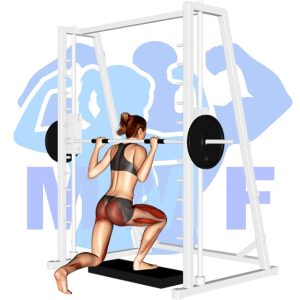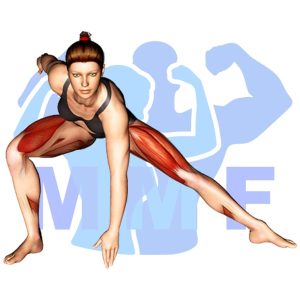Are you struggling to maintain proper form during your squat routine? Does your knee cave in or your ankle roll during the movement? If so, you might be in need of a squat sidekick. Don’t worry, you’re not alone. Many fitness enthusiasts face similar issues due to weak hip and glute muscles. But fear not, incorporating the squat sidekick exercise into your routine can help strengthen these muscles and improve your squat form. In this post, we’ll dive into the benefits of the squat sidekick and provide step-by-step instructions on how to properly execute the exercise.
Squat Sidekick Summary
- Primary Muscles: Quadriceps
- Secondary Muscles: Adductor Magnus, Gluteus Maximus, and Soleus
- Equipment: Body Weight
- Mechanics Type: Compound
- Force: Push
- Utility: Basic or Auxiliary

Squat Sidekick Instructions
- Setup in a standing position, feet shoulder-width apart, in a comfortable stance.
- Squat down, bending at your hips and knees with your shoulders back to maintain good posture.
- Once you reach a challenging and comfortable depth, press up with enough force to press one foot off the ground and point your foot to the side; this is the kick.
- Bring your foot back to the starting position and squat again.
- Repeat the exercise but kick with the opposite leg this time.
- Continue alternating kicking legs for ten reps on each side.
Video Tutorial
Squat Sidekick Muscles
Target (Agonist)
Synergists
- Adductor Magnus
- Gluteus Maximus
- Soleus
Dynamic Stabilizers
Stabilizers
- Erector Spinae
- Levator Scapulae
- Trapezius – Middle
- Trapezius – Upper
Antagonist Stabilizers

Benefits of Squat Sidekick
The squat sidekick is an excellent exercise for targeting the quadriceps muscles. It helps to strengthen the muscles, as well as improve muscular endurance. Additionally, performing this exercise with proper form can help to improve balance and coordination. When performing the squat sidekick, it is important to keep your knees in line with your toes and focus on pushing your hips back and engaging the core. This will help you to maximize the benefits of this exercise, allowing you to achieve greater strength and stability in the quadriceps muscles.
Tips for Performing Squat Sidekick
Your at the right place if you’re trying to enhance your squat sidekick execution. Using these suggestions can allow you to take full advantage of this amazing workout. Concurrently with shaping your legs muscles, increasing movability, and also a reduced chance of injury can all be accomplished with this exercise. Let’s begin and explore how these suggestions will benefit you.
- Warm Up Properly: Make sure to warm up your muscles with light stretching and aerobic exercise prior to performing the Squat Sidekick. This will help reduce the risk of injury and ensure you get the most out of your workout.
- Maintain Proper Form: Ensure that your back is straight, your chest is up, and your knees are directly above your ankles throughout the entire exercise. This will help maximize the benefits of the exercise and reduce the chance of injury.
- Increase Intensity Gradually: Start out with a light weight and gradually increase the intensity as you become more comfortable with the exercise. This will help you build strength and endurance without risking injury.
Benefits and Tips Video
Frequent Mistakes To Avoid
Staying away from mistakes can be the distinction between a successful workout and a painful injury when performing squat sidekick. Additionally, achieving optimal results from this exercise requires proper technique, and avoiding perform typical mistakes can allow you to perform the exercise correctly and obtain optimal results. Not only can preventing these mistakes make you more toned, but also can assist in you feeling more assured and motivated when you hit the gym. So let’s get started on avoiding those common mistakes and making this exercise a standard part of your fitness training.
- Not using proper form: Squat Sidekicks require you to keep your core engaged and back straight while you are performing the exercise. If you don’t maintain proper form while doing the exercise, you may be putting yourself at risk of injury and not getting the full benefit of the exercise.
- Not using a full range of motion: To get the most out of your Squat Sidekick, it is important to use a full range of motion. This means that when you kick your leg out, it should extend fully and when you squat down, your hips should go below your knees. Not using a full range of motion can prevent you from getting the full benefit from the exercise.
- Not taking breaks: Taking breaks during an exercise routine is important to ensure that you give your body time to rest and recover. If you are doing Squat Sidekicks for an extended period of time without breaks, you may be putting yourself at risk for exhaustion or injury. Taking regular breaks will help you get the most out of your workout.
Find More Bodyweight Exercises Here
Variations and Complementary Exercises
As you look to increase the difficulty of your workout or need a break from the squat sidekick, there are several variations, complementary, and alternative exercises you can use. These exercises will help you target the same muscles as the squat sidekick, but with different movements and intensity levels.
Squat Hold

The squat hold is a great complementary or alternative exercise to the squat sidekick. It helps to develop strength in the lower body and core, while also improving balance and stability. To perform a squat hold, stand with your feet slightly wider than hip-width apart, and lower yourself down into a squat position. Keep your chest up and core engaged, hold for 30 seconds and then stand back up. This exercise can be done with or without weights, depending on your fitness level. Squat holds are an effective way to build strength and balance, making them an ideal complement to the squat sidekick.
Squat

The Squat is a great complementary or alternative exercise to the Squat Sidekick. It is a compound exercise that works multiple muscle groups in the legs, glutes, and core, making it an effective lower body workout. The Squat can also be modified to increase or decrease the difficulty of the exercise, making it suitable for any fitness level. Additionally, the Squat can be done with or without weights, allowing for more flexibility and variety in your workouts. Overall, the Squat is a great exercise to add to your routine to maximize the benefits of your Squat Sidekick workout.
Smith Machine Rear Lunge

The Smith Machine Rear Lunge is an excellent complementary or alternative exercise for the Squat Sidekick. It is a unilateral lower body exercise that strengthens the legs, glutes, and core. The movement involves stepping back with one leg while maintaining an upright torso, and then lowering down to a 90-degree knee bend in the rear leg. This exercise helps to improve balance, stability, and strength in the lower body, and can be used as a substitute for the Squat Sidekick if needed.
Check Out These Top Bodyweight Exercises
Plyo Split Squats

Plyo split squats are a great complementary or alternative exercise to the squat sidekick. This exercise is performed by holding a pair of dumbbells while in a lunge position. The lunge is then explosively extended and the athlete jumps up as high as possible before returning to the starting position. This exercise helps to strengthen the lower body, especially the glutes and quads. It also works on increasing power and stability throughout the lower body. Plyo split squats are a great way to add an extra dimension to your leg routine, and can be used as a substitute for more traditional squats.
Plyo Side Lunge

The Plyo Side Lunge is a great complement or alternative to the Squat Sidekick exercise. This exercise focuses on explosive power, balance, and coordination, as it requires you to jump into a lunge position while simultaneously bringing the opposite leg up. This requires the use of the core muscles and the glutes, while the squat motion of the Sidekick exercise focuses on the quads and hamstrings. This makes Plyo Side Lunge a great choice for developing strength and power in different areas of the lower body.
Half Squat

Half Squat is a great exercise for those who want to work on their lower body, but who don’t want to do the full squat. It is an excellent complementary or alternative exercise to the Squat Sidekick. Half Squat focuses on building strength and power in the lower body, while still providing an effective cardiovascular workout. To perform the exercise, start with your feet hip-width apart, and bend your knees until your thighs are parallel to the floor. Hold this position for a few seconds, then stand back up. This exercise can be made more challenging by holding a weight in each hand while performing the squat. Half Squat is an excellent way to build strength and endurance in the legs and buttocks without putting too much strain on the knees.
Find More Legs Exercises Here
Opposing Complementary Exercises
For greater overall balance and strength, it is important to incorporate opposing muscle groups into your fitness routine. To supplement the exercise Squat Sidekick, here is a list of exercises that target the opposite muscle groups:
Resistance Band Single Leg Curls

Resistance Band Single Leg Curls are an ideal complement to Squat Sidekicks, as they use the opposing muscle group. This exercise strengthens the hamstrings and glutes while working on balance, stability, and coordination. The movement requires you to stand on one foot while keeping your hips level, holding the resistance band in both hands. Slowly curl your leg up while contracting your glutes and hamstrings until your knee is at a 90-degree angle. Lower your leg and repeat for 12-15 reps before switching sides. This exercise is great for building strength in the lower body and creating balance between the left and right legs.
Resistance Band Leg Curls

Resistance Band Leg Curls are an ideal exercise to complement the Squat Sidekick. This exercise works the opposing muscle group, targeting the back of the legs, specifically the hamstrings and glutes. It is a great way to build strength and stability in these areas, while also improving flexibility and balance. Resistance Band Leg Curls can be done standing or sitting, making them a great choice for any fitness level. This exercise can also be easily modified to increase or decrease intensity. When done in conjunction with Squat Sidekick, Resistance Band Leg Curls help create a balanced workout that strengthens the entire lower body.
Smith Machine Hip Thrust

The Smith Machine Hip Thrust is a great complement to the Squat Sidekick exercise, as it focuses on the opposite muscle group. The Smith Machine Hip Thrust works the glutes and hamstrings in a more isolated fashion, allowing the user to focus on recruiting these muscle groups specifically. The Squat Sidekick, on the other hand, works the quads, abductors, and adductors, making it a great way to target the entire lower body. Together, these two exercises provide a balanced and effective full-body workout.
Squat Sidekick: Boost Your Leg Day with a Fun Twist
Looking to give your leg day routine a new and exciting twist? The squat sidekick is the perfect move to add to your workout. This exercise not only targets your legs and glutes, but also activates your core and stabilizer muscles. By adding this move to your routine, you’ll not only improve your strength and coordination, but also challenge your balance and agility. Plus, it’s a fun way to switch up your regular squat routine and keep things interesting. Give the squat sidekick a try and see how it can elevate your leg day!
References: Wikipedia | ExRx.net | PubMed.gov | Comprehensive List of Legs Bodyweight Exercises

